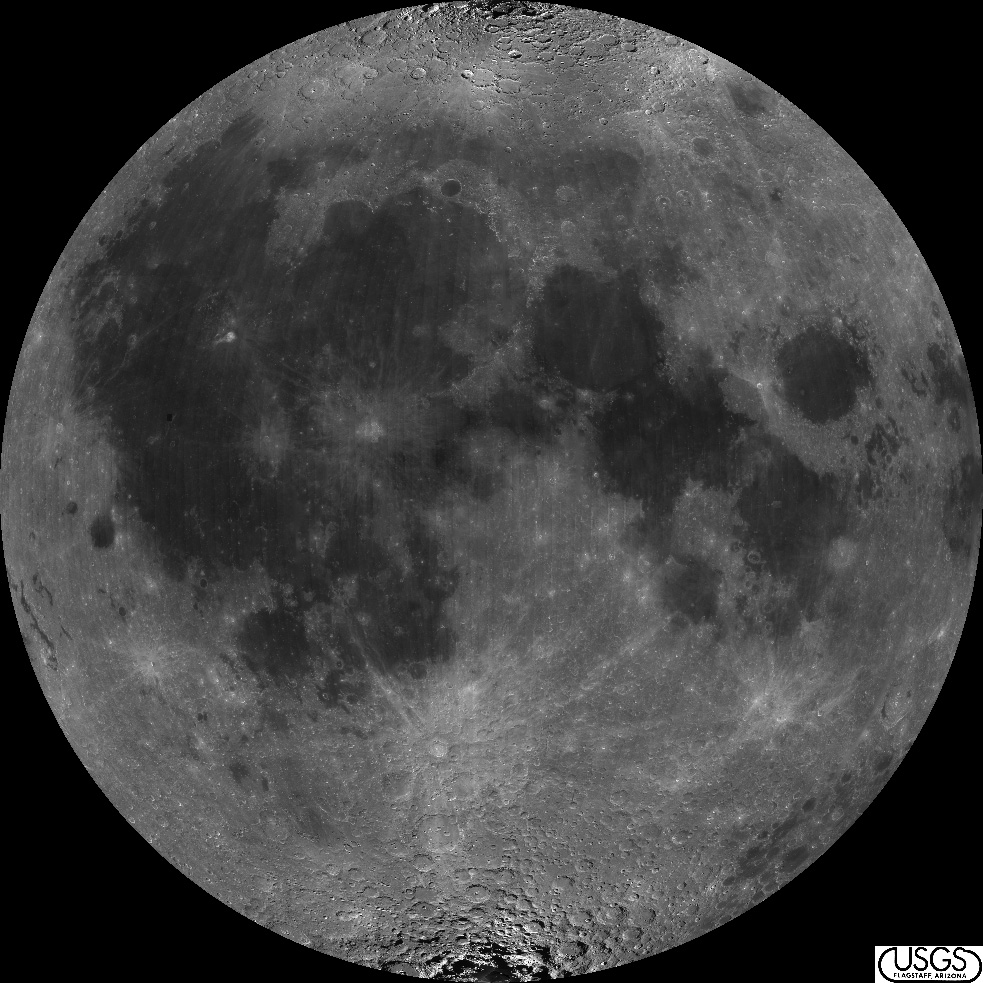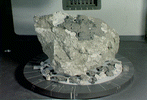
Moon

The Moon is the only natural satellite of Earth:
orbit: 384,400 km from Earth
diameter: 3476 km
mass: 7.35e22 kg
Called Luna by the Romans, Selene and Artemis by the Greeks, and many other names in other
mythologies.
The Moon, of course, has been known since prehistoric times. It is the second brightest
object in the sky after the Sun. As the Moon orbits around the Earth once per month, the
angle between the Earth, the Moon and the Sun changes; we see this as the cycle of the
Moon's phases. The time between successive new moons is 29.5
days (709 hours), slightly different from the Moon's orbital period (measured against the
stars) since the Earth moves a significant distance in its orbit around the Sun in that
time.
Due to its size and composition, the Moon is sometimes classified as a terrestrial
"planet" along with Mercury, Venus, Earth and Mars.
|
The Moon was first visited by the Soviet spacecraft Luna 2 in 1959. It is the only extraterrestrial body to have been visited by humans. The first landing was on July 20, 1969 (do you remember where you were?); the last was in December 1972. The Moon is also the only body from which samples have been returned to Earth. In the summer of 1994, the Moon was very extensively mapped by the little spacecraft Clementine. Lunar Prospector is now in orbit around the Moon |
The gravitational forces between the Earth and the Moon cause some interesting effects.
The most obvious is the tides. The Moon's gravitational attraction is stronger on
the side of the Earth nearest to the Moon and weaker on the opposite side. Since the
Earth, and particularly the oceans, is not perfectly rigid it is stretched out along the
line toward the Moon. From our perspective on the Earth's surface we see two small bulges,
one in the direction of the Moon and one directly opposite. The effect is much stronger in
the ocean water than in the solid crust so the water bulges are higher. And because the
Earth rotates much faster than the Moon moves in its orbit, the bulges move around the
Earth about once a day giving two high tides per day. In addition, the Earth's
rotation carries the Earth's bulges slightly ahead of the point directly beneath the Moon.
This means that the force between the Earth and the Moon is not exactly along the line
between their centers producing a torque on the Earth and an accelerating force on the
Moon. This causes a net transfer of rotational energy from the Earth to the Moon, slowing
down the Earth's rotation by about 1.5 milliseconds/century and raising the Moon into a
higher orbit by about 3.8 centimeters per year. (The opposite effect happens to satellites
with unusual orbits such as Phobos and Triton). The asymmetric nature of this
gravitational interaction is also responsible for the fact that the Moon rotates
synchronously, i.e. it is locked in phase with its orbit so that the same side is always
facing toward the Earth. Just as the Earth's rotation is now being slowed by the Moon's
influence, in the distant past the Moon's rotation was slowed by the action of the Earth.
In the latter case, however, the effect was much stronger. When the Moon's rotation
rate was slowed to match its orbital period (such that the bulge always faced toward the
Earth) there was no longer an off-center torque on the Moon and a stable situation was
achieved. The same thing has happened to most of the other satellites in the solar system.
Eventually, the Earth's rotation will be slowed to match the Moon's period, too, as is the
case with Pluto and Charon.
Actually, the Moon appears to wobble a bit (due to its slightly non-circular orbit) so
that a few degrees of the far side can be seen from time to time, but the majority of the
far side (left) was completely unknown until the Soviet spacecraft Luna 3 photographed it
in 1959. (Note: there is no "dark side" of the Moon; all parts of the Moon get
sunlight half the time, we just don't happen to see these parts).
The Moon has no atmosphere. But evidence from Clementine suggested that there may be water
ice in some deep craters near the Moon's south pole which are permanently shaded.
This, however, may have been misinterpretations of radar data due to surface effects.
The Moon's crust averages 68 km thick and varies from essentially 0 under Mare Crisium to
107 km north of the crater Korolev on the lunar farside. Below the crust is a mantle and
probably a small core (roughly 340 km radius and 2% of the Moon's mass). Unlike the
Earth's mantle, however, the Moon's is only partially molten. Curiously, the Moon's center
of mass is offset from its geometric center by about 2 km in the direction toward the
Earth. Also, the crust is thinner on the near side.
There are two primary types of terrain on the Moon: the heavily cratered and very old
highlands and the relatively smooth and younger maria. The maria (which comprise about 16%
of the Moon's surface) are huge impact craters that were later flooded by molten lava.
Most of the surface is covered with regolith, a mixture of fine dust and rocky debris
produced by meteor impacts. For some unknown reason, the maria are concentrated on the
near side.
Most of the craters on the near side are named for famous figures in the history of
science such as Tycho, Copernicus, and Ptolemaeus. Features on the far have more modern
references such as Apollo, Gagarin and Korolev (with a distinctly Russian bias since the
first images were obtained by Luna 3). In addition to the familiar features on the near
side, the Moon also has the huge craters South Pole-Aitken on the far side which is 2250
km in diameter and 12 km deep making it the the largest impact basin in the solar system
and Orientale on the western limb which is a splendid example of a multi-ring crater.
A total of 382 kg of rock samples were returned to the Earth by the Apollo and Luna
programs. These provide most of our detailed knowledge of the Moon. They are particularly
valuable in that they can be dated. Even today, 20 years after the last Moon landing,
scientists still study these precious samples.
Most rocks on the surface of the Moon seem to be between 4.6 and 3 billion years old. This
is a fortuitous match with the oldest terrestrial rocks which are rarely more than 3
billion years old. Thus the Moon provides evidence about the early history of the Solar
System not available on the Earth.
 Prior to the study
of the Apollo samples, there was no consensus about the origin of the Moon. There were
three principal theories: co-accretion which asserted that the Moon and the Earth formed
at the same time from the Solar Nebula; fission which asserted that the Moon split off of
the Earth; and capture which held that the Moon formed elsewhere and was subsequently
captured by the Earth. None of these work very well. But the new and detailed information
from the Moon rocks led to the impact theory: that the Earth collided with a very large
object (as big as Mars or more) and that the Moon formed from the ejected material. There
are still details to be worked out, but the impact theory is now widely accepted.
Prior to the study
of the Apollo samples, there was no consensus about the origin of the Moon. There were
three principal theories: co-accretion which asserted that the Moon and the Earth formed
at the same time from the Solar Nebula; fission which asserted that the Moon split off of
the Earth; and capture which held that the Moon formed elsewhere and was subsequently
captured by the Earth. None of these work very well. But the new and detailed information
from the Moon rocks led to the impact theory: that the Earth collided with a very large
object (as big as Mars or more) and that the Moon formed from the ejected material. There
are still details to be worked out, but the impact theory is now widely accepted.
The Moon has no global magnetic field. But some of its surface rocks exhibit remanent
magnetism indicating that there may have been a global magnetic field early in the Moon's
history.
With no atmosphere and no magnetic field, the Moon's surface is exposed directly to the
solar wind. Over its 4 billion year lifetime many hydrogen ions from the solar wind have
become embedded in the Moon's regolith. Thus samples of regolith returned by the Apollo
missions proved valuable in studies of the solar wind. This lunar hydrogen may also be of
use someday as rocket fuel.
The Moon has inspired much poetry and music, including the more contemporary background music and Beethoven's Moonlight Sonata.